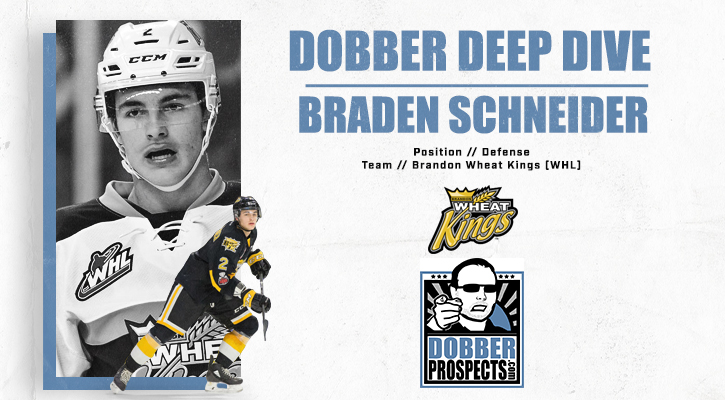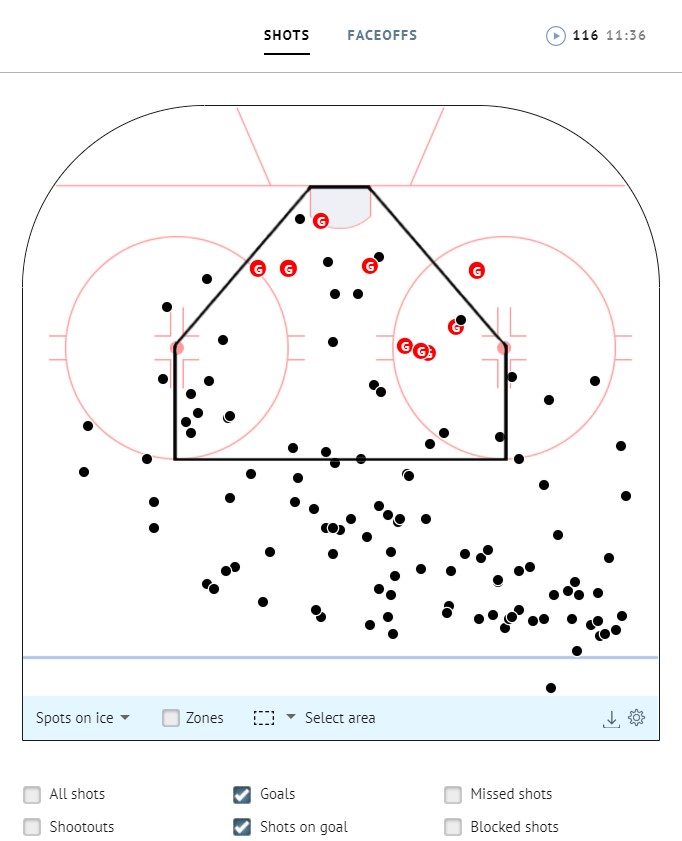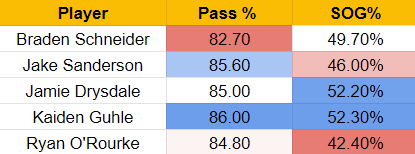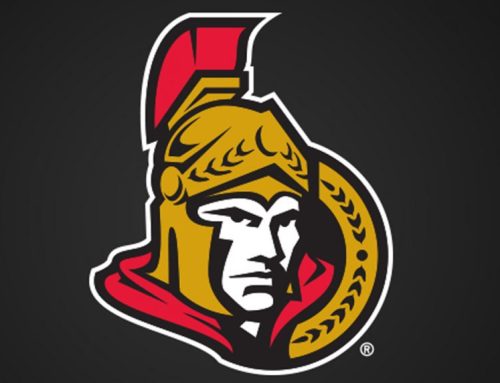Draft Class Deep Dive: RHD Braden Schneider
Tony Ferrari
2020-09-14

Graphic courtesy of Andrew Armstrong
Defense wins championships. We’ve all heard the phrase. Most coaches have probably said it at some point in time. It’s the go-to line when firing up talented offensive players who don’t commit defensively. It’s also the perfect justification for teams who draft defensive blueliners high in the draft. That’s where Braden Schneider comes into play. He might be the drafts top pure defensive blueliner in the 2020 draft class.
Just five days from being eligible for the 2019 NHL Draft, Schneider is one of the older players in the draft class. Expected to be a bit more NHL-ready than most prospects, the Wheat Kings defender understands the defensive game, reading incoming rushes and disrupting them and making the safe play. His style of play should translate to the next level quite well but may not present the greatest upside in terms of offensive potential. This style of play led to him almost making the Canadian World Junior squad after showing well at last summer’s World Junior Summer Showcase and strong defensive play early in the year in Brandon.

Braden Schneider bio information courtesy of Elite Prospects
There are many elements of Schenider’s game that do not show up on the boxscore. From excelling in defensive transitions to getting the puck out of the defensive zone at a very high rate, Schneider drives defensive results quite well. He may not end up being a star for your fantasy team but every team in the NHL needs a stout defensive presence on the back end. In today’s NHL, it is also imperative that the player can also move the puck up ice efficiently with his passing and skating. Braden Schneider is a player who could fit the bill.
*******
Transitional Defense
The area of Schneider’s game that may be strongest is his ability to defend the blueline. The best way to prevent being pinned in your own end is to not allow the opposition to enter the zone cleanly. Utilizing his frame, stick, and skating, the Saskatchewan native understands what he needs to do as the play unfolds in front of him.
In our first clip, we get exactly that. Schneider does an excellent job of identifying the attacking forwards neutral zone path and closing in quickly with his stuck in a good position. He stays in perfect position, minimizing the gap and staying within his stick length. Once disrupting the pass, he moves it quickly to safety.
Schneider is one of the best defenders in this class when it comes to denying clean zone entries. He uses a combination of aggressive gaps and an excellent stick to guide the attacker where he wants them and then separates the man from the puck. He doesn’t need to throw a big hit to utilize his physicality, oftentimes just cutting the play off with a strong body position. In the play below, we get a look at a couple of good zone entry defenses. Once with his stick, body position, and good puck recovery and movement. The second with the physicality he’s garnered a reputation for.
There are many times in games where entering the offensive zone of the right side against Schneider seems impossible because of his ability to thwart the play and move it up ice. Due to his immediate desire to get the puck to safety, the Brandon blueliner can dump the puck out without much consideration of a more possession driven decision. Despite giving the puck back to the opposition at times, he is more than up to the task when it comes to stopping them on their next attempt. Our next clip is an example of this and while it would be beneficial for Schneider to make a better decision at times, taking his time when he has it, he is effective at preventing offensive chances and this plays a factor in that.
To say that Schneider is a strong defender in transition would be a bit of an understatement. While it may not be a flashy trait, the reality of the situation is that Schneider does possess an elite trait. His ability to defend his own blueline, cutting off chances before they can get started.
Zone Exit Efficiency
Oftentimes the biggest detriment to a defensive rearguard is the ability to generate zone exits. There seems to be an endless supply of stone handed stone walls. What gives a player like Schneider the edge is his ability to create breakouts at a high rate. As we can see below, Schneider is able to utilize his skill to generate defensive zone breakouts. His hands are far from elite but they are above average which is good enough for an effective tertiary transitional carrying option at the next level. He shouldn’t be relied upon as the guy in transition but if he needs to take advantage because the opposition is thwarting the top puck carriers.
Schneider is a smart and effective transition player who makes good decisions and gets the puck out of his zone. As we can see from the chart below, Schneider ranks ahead of many of the top North American defenders in raw breakouts per game with 7.89, well ahead of top defender Jamie Drysdale. The other factor in play is his Controlled Breakout %, which at 33.96% ranks in the middle of the pack. This indicates that he is passing to generate breakouts or, as previously alluded to, dumping it out.

Transition Data courtesy of InStat Hockey. (EN = Entries, BR = Breakouts)
Passing is where the young Wheat Kings alternate captain excelled when it came to generating breakouts. When he gives himself time, not getting hasty with a dump out, he is a smart and effective puck mover. He is a good enough skater to threaten with carrying the puck up ice before passing to an open winger. When you at least present yourself as a threat as Schenider does in the following clip, you can freeze the opponent, even for just a second. This allows the defender to find a passing lane and move the puck with confidence.
Being mobile is key to excelling in the modern NHL and Schneider does a good job of staying fluid on his feet. Pivoting and chasing down pucks dumped in behind him are areas of strength. Below we can see him successfully pivot, locate, and gain good body position, closing the puck off to the forechecking attacker. He is able to move the puck to a free teammate and allowing his team the time to break out of the zone.
There is no denying that the effectiveness that Schneider brings when it comes to not only preventing clean entries but getting the puck quickly out of his zone. He is a real meat-and-potatoes player who doesn’t necessarily have a lot of flash to his game but he does the job that he is asked to do and has the puck skills to move the puck effectively unlike many players who fit the defensive-defender player type.
Offensive Capabilities
The biggest area of concern in Schneider’s game is his offensive upside. He is capable and shows the ability to facilitate but isn’t going to be a guy who plays on the powerplay at the next level. He often gives the impression of a player who can do some things offensively in junior hockey but the lack of refinement and high-level puck skills are often evident.
In the above video, we get a glimpse at Schneider’s skating and puck handling ability. He does a good job of evading opposing players through the neutral zone and hanging onto the puck, even if it does seem as if it could be lost at any second. He is able to circle the offensive zone and maintain control before passing it off as he returns to the blueline. He gets himself back into a defensive position having generated a decent threat entering the offensive zone.
One thing that seems to limit his offensive contributions was his hesitation to attack. There are many times in a game where if he were a bit more aggressive, with his skating and strength, he could get himself into a more dangerous position in the offensive zone. The next clip in our video study shows that very hesitation. He does a good job of passing the puck up ice and then when given the opportunity to get predatory in the offensive zone, he pulls back and continues playing conservatively.
This next play is an example of what he can do when he decides to be aggressive. Attacking space when given the opportunity and finding the back of the net. He has a very accurate shot and does a good job of locating his shot to take advantage of the excellent shooting position. The play above is far more common than the play below, however.
Part of the reason that this lack of aggression can be a bit frustrating is that Schneider possesses a very good shot. It isn’t the bomb that defenders are generally known for but it’s accurate, quick, and effective. In his shot chart below, we can see that he is extremely effective when getting into the home plate area. His shooting percentage jumps from 6.4% to 22.5% when he gets himself into high danger areas. This could indicate that he might have some sneaky goal-scoring ability, even if it doesn’t present itself as much as you’d like.

Shot chart courtesy of InStat Hockey
He provides promise as he shows enough skill to warrant a high selection. Schneider did a good job of scoring on the powerplay and showing that he can provide a capable set of hands on the back end and the ability to follow a set play as he does below. Nothing about what he does is overly skilled or flashy but he does a good job of doing his job. Schneider consistently does his job.
The most concerning thing for Schneider offensively is that he isn’t the most particularly accurate passer. He often makes the simple pass but as soon as the difficulty level is amped up, he struggles. As evidenced below, his passing percentage is quite a bit lower than his North American comparables. His ability to get shots through to the net is also middle of the pack. These two factors alone will likely mean that he is relegated to little to no offensive role at the next level.

Passing and shot data courtesy of InStat Hockey. (SOG% tracks how many shot attempts are on net)
Schneider is a capable offensive player but the upside in his game doesn’t come from his offensive game. The young Canadian rearguard shows the ability to facilitate and be a five-on-five presence who can transition the puck and move the puck at the offensive blueline but as the quality of competition ramps up, can his lackluster passing numbers improve enough to ensure that he can be capable at the next level?
Defensive Driving Force
It only seems fair to highlight how effective Schneider is in nearly all aspects of defensive play. His anticipation and understanding of body positioning are near the top of the draft class. His ability to close off along the wall, step in front of opponents, and secure the puck safely is born out of his understanding and ability to read what his opponents are going to do. The video below showcases his ability to not only anticipate the play but read where his outlets are.
This level of reading his opponents is impressive. He displays it with his stick positioning and where he guides defenders. He is also quite skilled when it comes to shadowing attackers and forcing them into making a play early or from a position of a disadvantage because of Schnieder’s pressuring.
As we watch the clip above, we have to appreciate the subtleties of Schneider’s positioning with both his stick and body as well as his agile footwork and ability to track throughout the defensive zone. His defensive IQ allows him to read the play and react accordingly. We can also look at some of the metrics below to understand just how strong Schneider is defensively. He is no worse than the middle of the pack in any one area and excels in areas such as defensive zone takeaways and overall opponent’s expected goals. This type of offensive suppression is rare in the modern game.

Defensive metrics courtesy of InStat Hockey. (GA = giveaways, TA = takeaways, xG = expected goals, TO Battles% = takeaways v. giveaways, Challenge % = any one-on-one battle)
Even in the modern NHL where players are faster and more skilled than ever, we watched Boston and St. Louis meet in last year’s Stanley Cup final, and teams like Toronto, Colorado, and Edmonton falter the last few seasons despite their immense offensive talent. Even offensive teams that have won such as Chicago or Washington have won with studs on their back end and excellent defensive results. Maybe defense really does win championships. If you believe it, Schneider goes a long way to building that defensive presence for those championship moments.
*******
Thank you for joining me on this player study. Schneider is a defense-first prospect who certainly seems like he has an NHL future and this deep dive helped clarify some details on my end, I hope it does the same for you. Be sure to check out Dobber’s DraftCast, the new podcast from DobberProspects, powered by InStat! I am joined by my co-host, Jokke Nevalainen, and we dive into all things NHL Draft. We recently had Will Scouch of Scouching.ca on to talk about risers and fallers. We also had Jimmy Hamrin from McKeens on to talk about Swedish prospects eligible for the 2020 NHL Draft!
For your fantasy hockey needs, the DobberProspects Fantasy Prospect Report and Fantasy Guide are the best sources to get you ahead of the game in your league whether you play in a simple year-to-year league or you’re involved in a decade long keeper league, the DobberProspects’ Fantasy Guides are your one-stop-shop for winning your league!
Shot chart and statistics such as passing percentage and challenge rate courtesy of InStat Hockey, a top of the line video and scouting platform. For more from InStat, follow them on Twitter. For more on prospects and the NHL Draft, you can follow Tony Ferrari on Twitter.
Draft Class Deep Dives






